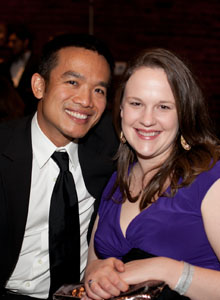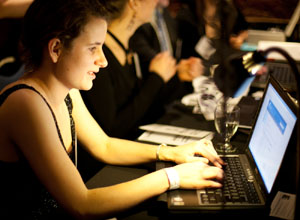PILA Wins with Technology
A Note from PILA Auction Chair Amy Jurden
When I took over as Auction Chair for this year's 20th Platinum Anniversary Auction my only goal was to find a way to grow the number of opportunities we could make available to students. That meant raising more funds.
We hit the mark: This year P.I.L.A. will provide just over $36,000 in awards to students working in public interest legal internships, nearly $8,000 more than our previous record. I have to extend my gratitude to the 35 men and women who dedicated countless hours to planning, promoting and executing this year's record-breaking event.
Why PILA Fellowships?
 My own experience with a public interest law internship was immensely important to my professional development. I was lucky enough to secure a position with the Health Law Partnership (HeLP), where I saw the practical application of the numerous hours spent studying case law and learning basic legal concepts. It was my first opportunity to interact with real clients in real need.
My own experience with a public interest law internship was immensely important to my professional development. I was lucky enough to secure a position with the Health Law Partnership (HeLP), where I saw the practical application of the numerous hours spent studying case law and learning basic legal concepts. It was my first opportunity to interact with real clients in real need.
Unfortunately, most organizations like HeLP cannot afford to pay their summer legal interns. In public interest law there is a lot of thanks – but there certainly is not a lot of money!
That is why the Fellowships awarded to students by GSU's Public Interest Law Association (P.I.L.A.) are so crucial. For many students, including myself, the only thing standing between practicing the public interest work they love and waiting tables for the summer are these Fellowships. The majority of the money raised for these Fellowships comes from the annual auction.
The Digital Auction
Professor Kendall Kerew had recently attended a fundraiser at her children's school that used smartphone technology to process silent auction bids and donations, and gave us the idea of bringing the P.I.L.A. auction into the digital age. Unfortunately, the product used by the school was prohibitively expensive, which made it impossible for us.
I later met with Earl Daniels, the College of Law's Database Administrator and Applications Developer to discuss our options. I expected that my wish for an electronic Silent Auction would go unfulfilled, but I had other items on my "electronic wish list" that consisted of much more than that. I wanted to make ticket sales easier and on-site registration more efficient; I wanted to throw out the pen and paper system.
Earl delivered. This allowed us to completely eliminate pen and paper accounting, and focus on increasing our ticket sales. P.I.L.A. volunteers worked toward earning a free ticket by selling tickets to others. Volunteers received coded links to share on Facebook, Google +, and other social networking sites that would tally sales and credit the volunteer.
 While I was discussing these solutions I told Earl about the electronic Silent Auction system I wanted. Despite my concerns, Earl believed wholeheartedly that he could develop it utilizing the resources the College of Law already had at its disposal.
While I was discussing these solutions I told Earl about the electronic Silent Auction system I wanted. Despite my concerns, Earl believed wholeheartedly that he could develop it utilizing the resources the College of Law already had at its disposal.
In August we had a brainstorming session with eight other students to develop ideas for how we wanted the solution to work and what it would look and feel like; then Earl went to work.
The week before the auction the solution was ready to be rolled out. It was both exciting and terrifying. What if it crashed? What if nobody could figure out how to use it? What if we raised less money than before?
On auction night, bidders had the option of using text messaging, smartphones to access the web-based application, or one of eight computer terminals to place their bids. The night of the auction came and went with only one minor, easily fixable glitch – not bad for a solution that only six months earlier didn't exist!
The increased accessibility – guests could bid from their tables or even from home – coupled with the increased number of attendees (nearly 500), resulted in items going for near or above their fair market value.
The Future of the P.I.L.A. Auction
This year's solution can be used and improved in future years, resulting in increased bids and donations. Future volunteers will be able to tout the marketing benefits of putting sponsors' names in front of 400-500 attorneys and future attorneys.
I envision even being able to “sell” advertising space, resulting in even more money raised for Fellowships. And so I give a special thanks to Professor Kerew for the inspiration and to Earl Daniels for making that inspiration a reality.
I want to also extend thanks to my tireless volunteers – in particular my Co-Chairs, Jill Skinner and Lindsay Anglin, and to all of my volunteers and committee heads, without whom this would not have been possible. And finally, to the Student Trial Lawyers Association, who donated $6,000 to support internships for prosecutors, and the numerous individual donors that comprised the rest of our record breaking total.
All photos by Joe Shen. View the full photo set at Picasa.